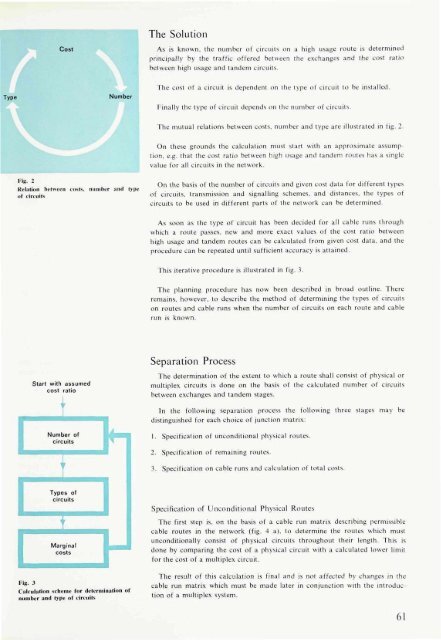The Ericsson Group 1968 - History of Ericsson - History of Ericsson
The Ericsson Group 1968 - History of Ericsson - History of Ericsson
The Ericsson Group 1968 - History of Ericsson - History of Ericsson
You also want an ePaper? Increase the reach of your titles
YUMPU automatically turns print PDFs into web optimized ePapers that Google loves.
Fig. 2<br />
Relation between costs, number and type<br />
<strong>of</strong> circuits<br />
Fig. 3<br />
Calculation scheme for determination <strong>of</strong><br />
number and type <strong>of</strong> circuits<br />
<strong>The</strong> Solution<br />
As is known, the number <strong>of</strong> circuits on a high usage route is determined<br />
principally by the traffic <strong>of</strong>fered between the exchanges and the cost ratio<br />
between high usage and tandem circuits.<br />
<strong>The</strong> cost <strong>of</strong> a circuit is dependent on the type <strong>of</strong> circuit to be installed.<br />
Finally the type <strong>of</strong> circuit depends on the number <strong>of</strong> circuits.<br />
<strong>The</strong> mutual relations between costs, number and type are illustrated in fig. 2.<br />
On these grounds the calculation must start with an approximate assumption,<br />
e.g. that the cost ratio between high usage and tandem routes has a single<br />
value for all circuits in the network.<br />
On the basis <strong>of</strong> the number <strong>of</strong> circuits and given cost data for different types<br />
<strong>of</strong> circuits, transmission and signalling schemes, and distances, the types <strong>of</strong><br />
circuits to be used in different parts <strong>of</strong> the network can be determined.<br />
As soon as the type <strong>of</strong> circuit has been decided for all cable runs through<br />
which a route passes, new and more exact values <strong>of</strong> the cost ratio between<br />
high usage and tandem routes can be calculated from given cost data, and the<br />
procedure can be repeated until sufficient accuracy is attained.<br />
This iterative procedure is illustrated in fig. 3.<br />
<strong>The</strong> planning procedure has now been described in broad outline. <strong>The</strong>re<br />
remains, however, to describe the method <strong>of</strong> determining the types <strong>of</strong> circuits<br />
on routes and cable runs when the number <strong>of</strong> circuits on each route and cable<br />
run is known.<br />
Separation Process<br />
<strong>The</strong> determination <strong>of</strong> the extent to which a route shall consist <strong>of</strong> physical or<br />
multiplex circuits is done on the basis <strong>of</strong> the calculated number <strong>of</strong> circuits<br />
between exchanges and tandem stages.<br />
In the following separation process the following three stages may be<br />
distinguished for each choice <strong>of</strong> junction matrix:<br />
1. Specification <strong>of</strong> unconditional physical routes.<br />
2. Specification <strong>of</strong> remaining routes.<br />
3. Specification on cable runs and calculation <strong>of</strong> total costs.<br />
Specification <strong>of</strong> Unconditional Physical Routes<br />
<strong>The</strong> first step is, on the basis <strong>of</strong> a cable run matrix describing permissible<br />
cable routes in the network (fig. 4 a), to determine the routes which must<br />
unconditionally consist <strong>of</strong> physical circuits throughout their length. This is<br />
done by comparing the cost <strong>of</strong> a physical circuit with a calculated lower limit<br />
for the cost <strong>of</strong> a multiplex circuit.<br />
<strong>The</strong> result <strong>of</strong> this calculation is final and is not affected by changes in the<br />
cable run matrix which must be made later in conjunction with the introduction<br />
<strong>of</strong> a multiplex system.<br />
61
















